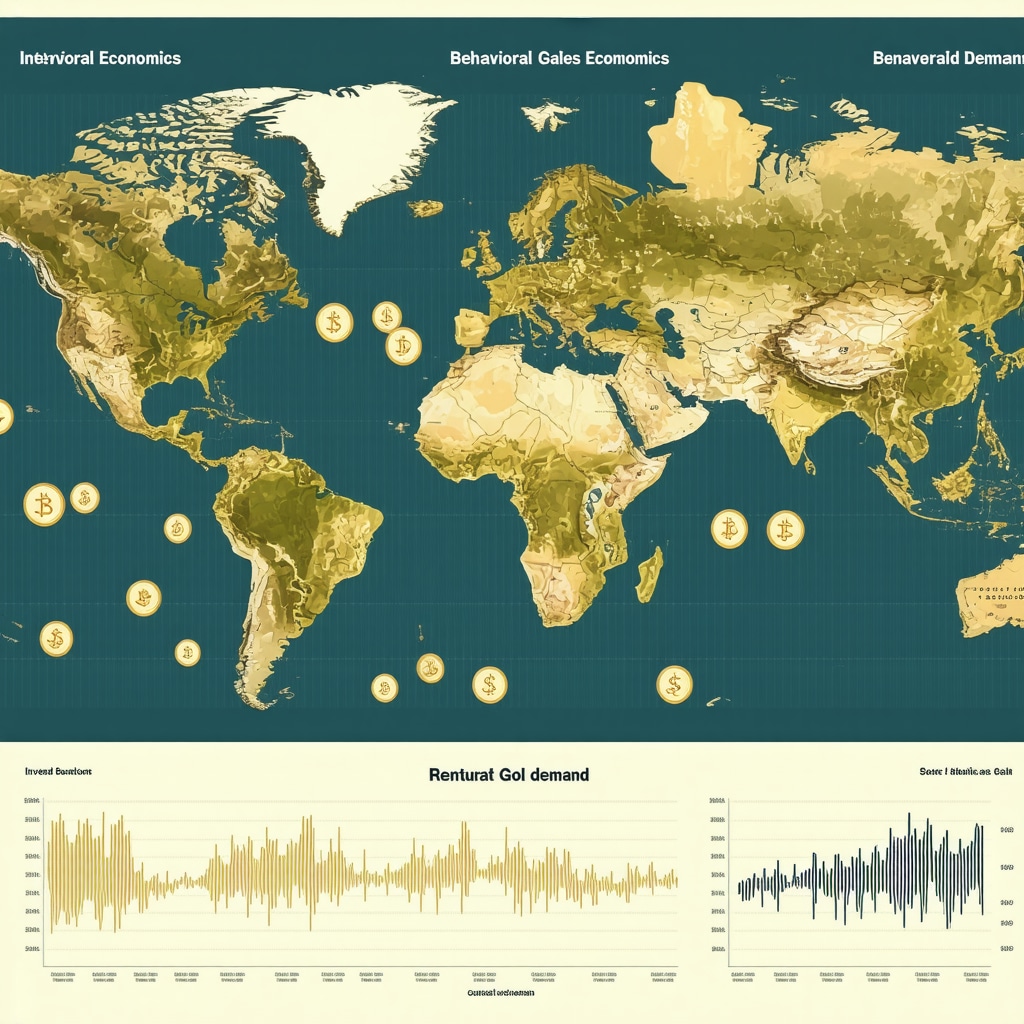Unlocking the Secrets Behind Gold Demand Dynamics
Investing in gold is more than just tracking prices; it’s about understanding the intricate demand trends that shape the market’s pulse. As global economic uncertainties and geopolitical tensions fuel investor interest, analyzing gold demand trends becomes an indispensable skill for crafting smarter investment strategies. This article dives deep into the patterns and forces driving gold demand, empowering you to make informed decisions that align with evolving market realities.
Decoding Global Gold Consumption: Beyond the Surface
Gold demand is a multifaceted phenomenon influenced by various sectors such as jewelry, technology, central banks, and investment vehicles. Jewelry continues to dominate consumption, especially in culturally significant markets like India and China, where gold holds both aesthetic and symbolic value. Meanwhile, technological demand, though smaller, steadily grows with innovations in electronics and medical devices. Central banks’ strategic purchases often signal shifts in financial stability perceptions, while investors flock to gold ETFs, mutual funds, and bullion during times of market volatility.
Understanding these diverse consumption categories offers a panoramic view of where demand originates and how shifts in these areas can foreshadow price movements. For instance, a surge in central bank gold acquisitions often precedes upward price trends, reflecting hedging against currency risks or inflationary pressures.
Harnessing Data Analytics: Tools to Track and Forecast Gold Demand
Advanced data analytics now enable investors to dissect gold demand trends with greater precision. Monitoring import-export statistics, central bank reports, and investment fund flows provides quantifiable insights into market sentiment. For example, the World Gold Council publishes comprehensive quarterly demand statistics that can serve as a reliable foundation for analysis.
In addition to raw data, sentiment analysis from news and social media platforms can reveal emerging investor attitudes that traditional metrics might miss. Combining technical price trend analysis with fundamental demand data offers a holistic approach to anticipating market shifts.
How Can Investors Identify Reliable Signals Amidst Complex Gold Demand Trends?
Investors should look for converging indicators such as rising jewelry sales in emerging economies, increased central bank buying, and growing inflows into gold-backed ETFs. When these factors align, they often presage stronger demand and potential price appreciation. It’s crucial to differentiate between short-term speculative spikes and sustained demand growth by evaluating historical patterns and macroeconomic contexts.
Moreover, geopolitical events like trade wars or currency devaluations can abruptly alter demand trajectories. Staying informed through authoritative sources like the World Gold Council’s demand trends reports ensures investors ground their strategies in verified data rather than hearsay.
Integrating Gold Demand Insights into Your Investment Portfolio
Armed with a nuanced understanding of gold demand, investors can optimize their portfolios by selecting appropriate gold investment vehicles. Physical gold, ETFs, mutual funds, and futures contracts each react differently to demand trend changes. For instance, increased consumer jewelry demand might signal opportunities in bullion and coins, whereas central bank purchases could benefit ETFs and mining stocks.
For a deeper dive into how to leverage gold demand trends for portfolio growth, consider exploring this expert guide on analyzing gold demand trends that offers actionable tips tailored for 2025 market conditions.
Feel inspired to share your experiences or ask questions about gold demand trends in the comments below—your insights enrich our investing community.
Navigating the Emotional Currents Behind Gold Demand
From my experience, understanding gold demand isn’t just about numbers — it’s about recognizing the emotional and cultural drivers that fuel buying behavior worldwide. When I first started paying attention to jewelry demand in India, I realized it’s deeply intertwined with festivals, weddings, and traditions that don’t always follow predictable economic patterns. That emotional attachment creates a steady, resilient demand that often cushions gold prices during turbulent times.
Similarly, central banks’ gold purchases often reflect their confidence (or lack thereof) in fiat currencies. I recall reading how certain countries boosted their gold reserves amid geopolitical tensions, signaling a strategic move to safeguard national wealth. These insights helped me anticipate market shifts better than relying on price charts alone.
Why Does Gold Demand Spike in Times of Uncertainty?
When markets wobble or inflation fears rise, gold demand tends to surge as investors seek a safe haven. I’ve noticed that during such periods, ETFs and mutual funds focused on gold often see significant inflows. This trend is backed by data from the World Gold Council, which highlights how investment demand can quickly outpace other sectors, driving prices higher (source).
Interestingly, technological innovations also play a subtle role. As electronics and medical industries increase their gold usage, this steady industrial demand adds another layer of support to prices, even when investment sentiment fluctuates.
Have You Ever Considered How Cultural Events Impact Your Gold Investments?
This question struck me after observing how seasonal festivals in Asia cause predictable shifts in gold buying patterns. These events can create windows of opportunity for investors who understand the timing and scale of demand surges. For example, the Indian festival season often triggers a spike in gold jewelry purchases, which can ripple through the market price.
Applying Gold Demand Knowledge to Your Portfolio Strategy
Integrating these insights into my own investment approach has been transformative. Recognizing when physical gold purchases dominate versus when financial instruments like ETFs gain traction allows me to adjust my allocations accordingly. For those looking to enhance their portfolio, exploring diversified gold investment options is key. Whether it’s physical gold bars, coins, or ETFs, each has unique responses to demand trends.
If you’re eager to learn more about building a resilient portfolio that leverages these dynamics, check out this comprehensive guide on gold ETFs and diversification. It’s packed with strategies that reflect the latest market realities for 2025.
What are your experiences with gold demand trends? Have cultural or geopolitical factors influenced your investment decisions? Share your stories and questions below — I love hearing from fellow investors navigating this fascinating landscape!
Decoding the Geopolitical Chessboard: How International Relations Shape Gold Demand
Gold’s role as a geopolitical barometer is often underestimated yet profoundly impactful. Beyond economic indicators, shifts in international diplomacy, sanctions, and trade agreements can trigger significant movements in gold demand. For example, when geopolitical tensions escalate in major economies, central banks and investors alike tend to pivot toward gold as a haven to mitigate currency risks and preserve wealth. This dynamic underscores the necessity for investors to not only monitor traditional financial metrics but also stay attuned to geopolitical developments that can rapidly alter demand trajectories.
Consider the recent surge in gold purchases by countries aiming to diversify reserves away from US dollars amidst rising trade frictions. This move not only reflects a loss of confidence in dominant currency regimes but also signals a strategic hedging approach that could redefine global gold demand patterns in the coming years.
Innovative Analytical Frameworks: Merging Behavioral Economics with Gold Demand Forecasting
Traditional quantitative models often fall short in capturing the psychological nuances underlying gold demand fluctuations. Integrating behavioral economics into demand forecasting provides a richer, more granular understanding of investor sentiment and decision-making biases. For instance, the “flight to safety” phenomenon, where investors flock to gold during market stress, can be analyzed through the lens of loss aversion and herd behavior, offering predictive insights beyond mere price movements.
Advanced machine learning algorithms now incorporate sentiment analysis from social media alongside economic indicators, enabling real-time detection of shifts in investor mood that precede physical and financial gold demand changes. These hybrid models are proving invaluable for institutional investors seeking to anticipate market inflection points with greater accuracy.
What Are the Emerging Risks That Could Disrupt Established Gold Demand Patterns?
While gold has historically been a stalwart safe haven, emerging risks such as digital currency adoption, evolving monetary policies, and climate change-related economic disruptions pose complex challenges. The gradual shift toward central bank digital currencies (CBDCs) may alter the role of gold in reserve portfolios, potentially reducing demand or transforming how gold is utilized as a financial instrument.
Moreover, unpredictable monetary tightening cycles and inflation trajectories complicate gold’s traditional hedge function. Investors must, therefore, adopt a multidimensional risk assessment approach that considers these disruptive factors alongside conventional demand drivers.
For a detailed exploration of these evolving risks, consult the IMF Working Paper on CBDCs and Gold Demand, which provides comprehensive analysis on this frontier.
Customizing Gold Investment Vehicles to Match Complex Demand Signals
Recognizing that different gold investment vehicles respond uniquely to demand dynamics is critical for sophisticated portfolio construction. Physical gold tends to react swiftly to cultural and jewelry demand shifts, while ETFs and mining equities often mirror financial market volatility and central bank behaviors. Futures and options add an additional layer of leverage and risk management, suitable for traders with advanced expertise.
Portfolio managers increasingly employ tactical allocation strategies, adjusting exposure across these vehicles based on forecasted demand signals. For instance, a predicted rise in technological gold use might prompt increased positions in mining stocks with strong innovation pipelines, whereas heightened central bank buying could favor ETFs closely tracking bullion holdings.
Integrating these nuanced insights requires continuous market intelligence and agile execution capabilities to optimize returns while managing risks effectively.
Curious about tailoring your portfolio with these advanced gold demand insights? Engage with our expert community or reach out for personalized advisory to harness these complex dynamics effectively.

Unraveling Emerging Disruptors in Gold Demand Trajectories
As gold’s historic role as a financial safe haven endures, the landscape is increasingly shaped by novel challenges that could unsettle established demand patterns. The ascent of central bank digital currencies (CBDCs) presents a pivotal transformation, potentially recalibrating gold’s status within reserve portfolios and altering how it functions as a financial instrument. This shift necessitates that investors remain vigilant to technological innovations that may erode traditional gold demand or redefine its strategic utility.
Concurrently, volatile monetary policies and unpredictable inflation trends compound the complexity of gold’s hedge attributes. The intertwining of these macroeconomic variables demands a multidimensional risk assessment framework, one that integrates both conventional and emerging drivers to forecast gold demand with greater accuracy.
How Can Behavioral Economics Enhance Forecasting Models for Gold Demand?
Incorporating behavioral economics into gold demand forecasting transcends traditional quantitative approaches by capturing the psychological underpinnings of investor decisions. Phenomena like loss aversion and herd behavior elucidate the “flight to safety” trends observed during periods of financial distress, offering predictive insights that pure price analysis might overlook. Advanced machine learning models now synthesize sentiment data from social media and news sources with economic indicators, enabling real-time anticipation of shifts in both physical and financial gold demand.
Such integrative frameworks equip institutional investors with a sophisticated toolkit to identify market inflection points ahead of time, thereby optimizing strategic allocations and mitigating downside risks.
Strategically Aligning Investment Vehicles with Complex Demand Signals
A nuanced understanding of gold demand intricacies empowers portfolio managers to tailor investment vehicles according to distinct market stimuli. Physical gold remains sensitive to cultural and jewelry consumption spikes, whereas ETFs and mining equities are more reactive to financial market volatilities and central bank policies. Futures and options provide leverage and risk management avenues for advanced traders prepared to navigate heightened uncertainties.
Employing tactical asset allocation that dynamically adjusts exposure based on predictive demand analytics enhances portfolio resilience. For example, a forecasted increase in technological gold utilization might justify bolstering positions in mining companies with robust innovation pipelines, while anticipated central bank accumulation could shift preference toward bullion-backed ETFs.
Such sophisticated strategies demand continuous market intelligence and agile execution to capitalize on evolving demand dynamics effectively.
For an in-depth examination of these emerging trends and advanced portfolio strategies, consult the IMF Working Paper on CBDCs and Gold Demand, a comprehensive resource elucidating these complex interactions.
Ready to elevate your gold investment approach by integrating these advanced insights? Join our expert community or contact our advisory team to tailor strategies that harness these multifaceted demand drivers with precision.

Frequently Asked Questions (FAQ)
What are the main factors driving global gold demand?
Global gold demand is primarily influenced by jewelry consumption, investment demand, central bank purchases, and industrial uses. Jewelry dominates in culturally significant markets like India and China, while investment demand spikes during economic uncertainty. Central banks strategically acquire gold to diversify reserves and hedge against currency risks. Technological applications, though smaller, contribute steadily.
How do geopolitical events impact gold demand?
Geopolitical tensions often trigger increased gold demand as investors and central banks seek safe havens to protect wealth amid uncertainty. Trade disputes, sanctions, and diplomatic shifts can prompt central banks to diversify reserves with gold, while investors flock to gold-backed instruments to hedge against market volatility and currency devaluation.
Can behavioral economics improve forecasting of gold demand trends?
Yes, behavioral economics integrates psychological factors like loss aversion and herd behavior into forecasting models, providing deeper insight into investor motivations during market stress. Combined with sentiment analysis and machine learning, it enables anticipation of demand shifts beyond traditional quantitative data.
What role do central bank digital currencies (CBDCs) play in future gold demand?
The rise of CBDCs may reshape gold’s role in reserve portfolios by offering alternative digital assets. This could reduce traditional gold demand or transform how gold is utilized financially. However, the transition remains complex and uncertain, requiring investors to monitor developments closely.
How should investors tailor their gold investments based on demand trends?
Investors should align their holdings with specific demand drivers. Physical gold is sensitive to jewelry and cultural consumption, ETFs and mining equities respond to financial market and central bank activity, while futures and options suit advanced traders managing risk and leverage. Dynamic allocation informed by demand analytics enhances portfolio resilience.
What are emerging risks that could disrupt gold demand?
Emerging risks include digital currency adoption, volatile monetary policies, inflation unpredictability, and climate-related economic disruptions. These factors may alter gold’s traditional safe-haven role and require multifaceted risk assessments integrating both conventional and novel drivers.
How can data analytics be used to track and forecast gold demand?
Advanced analytics combine import-export data, central bank reports, investment flows, and sentiment analysis from news and social media. This multifaceted approach offers real-time insights into market sentiment and demand shifts, helping investors anticipate price movements more accurately.
Why does gold demand often spike during certain cultural events?
In markets like India, festivals and weddings drive predictable surges in jewelry purchases, creating seasonal demand peaks. Understanding these cultural patterns allows investors to anticipate periods of heightened physical gold demand, which can influence overall market dynamics.
How do technological innovations affect gold demand?
Technological industries, including electronics and medical devices, steadily increase gold usage for its conductivity and biocompatibility. While smaller than other sectors, this industrial demand provides stable support for gold prices, especially during periods when investment demand fluctuates.
What is the best way to stay informed about gold demand trends?
Reliable sources include reports from the World Gold Council, central bank publications, reputable financial institutions, and specialized research papers. Combining these with advanced data analytics and sentiment monitoring ensures well-rounded and timely insights for informed investment decisions.
Trusted External Sources
- World Gold Council (WGC): As the leading authority on gold demand and supply, WGC provides comprehensive quarterly reports and in-depth analyses essential for understanding global consumption patterns and investment flows.
- International Monetary Fund (IMF): The IMF offers critical research papers, such as those examining the impact of central bank digital currencies on gold demand, providing insights into emerging financial system dynamics affecting gold markets.
- Bloomberg Intelligence: This financial data and analytics provider delivers real-time market intelligence and expert commentary on gold price drivers, geopolitical impacts, and investment trends.
- Metals Focus: An independent precious metals research firm that offers detailed annual and quarterly gold market reports, valuable for granular data on production, consumption, and demand forecasting.
- London Bullion Market Association (LBMA): The LBMA sets standards for the global gold market and publishes authoritative market updates, facilitating transparent and reliable information on bullion trading and demand.
Conclusion
Understanding gold demand trends requires a multifaceted approach that blends economic data, geopolitical awareness, behavioral insights, and technological foresight. Jewelry consumption, central bank strategies, investment flows, and industrial uses each uniquely influence gold’s market dynamics. Emerging disruptors like central bank digital currencies and shifting monetary policies add complexity to forecasting gold’s future role.
By integrating advanced analytics and behavioral economics, investors can anticipate demand shifts with greater precision, aligning their portfolios with nuanced market signals. Tailoring investment vehicles—whether physical gold, ETFs, mining stocks, or derivatives—to these complex drivers enhances resilience and growth potential.
Harnessing these expert insights empowers you to navigate the evolving gold landscape confidently. Share your perspectives, pose questions, and explore related expert content to deepen your mastery of gold demand dynamics. Together, let’s unlock smarter strategies for investing in gold’s enduring value.









